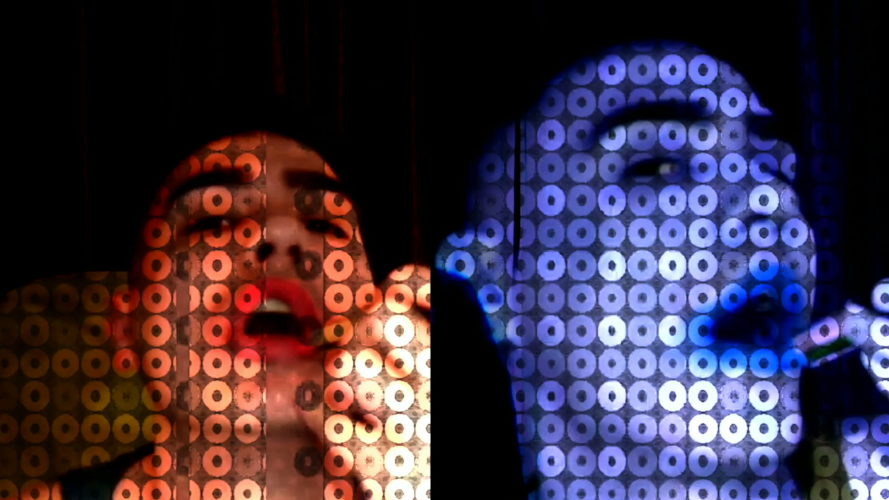The lipstick wearer has been marked for centuries by the obligation to communicate well-being and social status. Yet lipstick has also, often simultaneously, been the mark of questionable morals: a sign of personal choice to show a more lavish self, or a sign, enforced by the law, of ill-repute. And lipstick has been successfully worn not only by prostitutes and queens but also by women and men alike. For generations in European culture, makeup was available to both sexes, as masculinity was expressed by the usage of eyeliners, red pigments, white powders, and beauty marks. How then did this gender-inclusive mindset disappear from the cultural mainstream? During the early Victorian Era, the church, under the rule of Great Britain’s Queen Victoria, pushed for makeup to be linked exclusively with femininity and self-worship, and as makeup acquired an excessively Mephistophelian aura, putting on makeup was gradually perceived within European culture as an exclusively effeminate activity. It would thus seem that the lipstick wearer has suffered a profound metamorphosis of meaning.
As a makeup lover, as one who proclaims her own personas and femininity by applying different types of lipstick and selective makeup patterns, I have been intrigued by Franz Cerami’s installation: Lipstick Portraits. Cerami’s art is at the meeting point of digital technology and manual painting, and his upcoming digital show during Cyfest (the largest international media arts festival held at the Royal Palace of Caserta), promises to charm us with a mélange of digital portraits, of 15 men and women from around the world captured by means of webcam. Here, as in many of his installations, Cerami tackles social taboos and the shift in moral values, both of which function simultaneously in the digital world. Being both a storyteller and a digital artist, Franz Cerami wishes to mix and merge the narratives rooted in intimate life, while also examining the metamorphosis of meaning from the private to the digital space.
Curious to know more about his work, I found myself navigating Cerami’s Instagram page, staring at a video of a beautiful, bearded man, his right hand moving around his mouth while applying lipstick. Going around and around with the lipstick pressed against his mouth, playing with what is at odds with today’s expectations of masculinity, and with his eyes looking directly into the camera, his actions clearly address the viewer who is urged to participate in the intentions of the performer. While the act of applying lipstick might be seen as feminine, the onlooker cannot ignore the vigorous and clear signs of the masculinity he embodies. With a clear break from the model of heterosexual identity, what the lipstick reveals in him is how masculinity is a social construct, which could be understood by some as homosexuality. Here, the lipstick itself functions as a means of transferring female sexuality onto the one who’s applying it. But the risk for men, as in this case, will always be the loss of masculinity in the public space, the loss of face itself by revealing the feminine side.
Yet the use of lipstick, again merging with the fabrication of identity, also poses a risk for women: another Instagram video of a woman seems to be invested as well with a forceful overflow of femininity which gently, but surely, transforms into erotica. As a viewer of these videos, I could literally see the abundance of meaning generated by the action of applying lipstick. And at the same time, I was also aware of our cultural constraints, and how the meaning of wearing it seems to be risky for both sexes because feminine men and erotic women are disapproved of in many social contexts.
A week before Franz Cerami found me on social media, I had created, for the first time ever, some short videos, reviewing some nude lip glosses I had bought from a very famous makeup line. Having studied literature and philosophy, I decided to make these videos on makeup as playful as I could. They were not meant to pass as professional videos, and so I really had no expectation that a stranger would take any interest in them. But Franz found them, and over the course of seven days, him and I decided over a Skype call that I would take part in his upcoming digital installation The Lipstick Portraits.
My story, a common one in Eastern Europe, is more open-minded in some ways, yet it still carries the marks of a prudish legacy: as a video participant, I felt conflicted because not only was I yearning to listen to Franz, but at the same time I felt an unexplored shame, arising through the simple act of applying lipstick in front of a webcam. By engaging with the anatomy of my mouth and the subversive narrative of applying lipstick, I felt myself suddenly frightened to surrender in front of a person whom I barely knew. Playing with lipstick, identity, and sexuality, I had the impression that by showing my face in front of a camera, as a female, and by challenging and changing the impressions others had of me, my actions had the potential to harm me. I was literally terrified by the diverse ways with which people could interpret my actions.
As I gradually opened to the potentiality of my mouth, that anatomically it has the potential to change, and by listening to Franz’s suggestions—how close to the camera I should be, when I should apply the lipstick, and when I should stop— I thought about what this could mean in front of an unschooled viewer: that I was basically asking for sex. And yet despite these conflicting feelings and while listening to my intuition, something interesting happened: I found an antidote for shame. At the end, defying these thoughts of shame, I continued to move the lipstick around my mouth, until after some time, I was finally able to let these thoughts go.
Erotically invested, I did feel this experience was intended to give expression to the multiple layers through which the public and private become interconnected by exploring the power of the cultural legacy of todays techno-anthropoloy and sexuality. And as the power of technology is present more and more in our daily lives, it can both reinforce and disenfranchise meaning; but it can also work to free us, to create new and different meanings. Being used by the vast majority as an entertainment source, what Cerami really wants us to ask ourselves , by revealing the secrets of these ongoing processes, are we willing to transcend technology’s main purpose? Could we exceed or transgress the dominant discourse by not only understanding but also by creating different, more nuanced meaning?
And as how our shared future looks like still remains unknown, I cannot stop thinking that, me, as a pledged witness to this phenomena, I will choose from now on to accept and unlock these parallel realities, as long as shifting the popular paradigm will be in sight.
POSTED BY
Alexandra Cozma
Alexandra Cozma (b. 1987) is a freelance creative and content writer. She moved to Vienna in 2012 after finishing her studies in universal comparative literature and norwegian at the Babeș-Bolyai-Uni...




Comments are closed here.